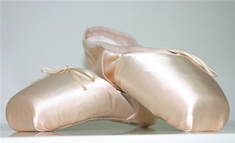First introduced to the stage in the early 1800s, pointe shoes allow ballerinas to dance on their toes giving them an ethereal quality. These shoes are strong enough to support the dancer.
Despite what some may think, pointe shoes are made simply of burlap hardened with glue. The shoes, covered with satin, have two main structural features: the box and the shank. The box is an encasing of burlap reinforced with glue to protect the dancer's toes. The shank, usually pressed cardboard or fiberboard, forms the sole to support the arch.
Priced between $45 and $100 per pair, pointe shoes are not cheap and make the art form a costly profession. For some, namely students, the shoes can last two to four months. However, the shoes of professional dancers, working long hours, usually last only as long as one performance or rehearsal.
 Teachers recommend that girls begin dancing en pointe between the
ages of 11 and 13, since pointe work requires strong muscles in the ankles,
legs, and lower adominals. The dancer should also have had several years of
training and only work under the watchful eye of an experienced
teacher.
Teachers recommend that girls begin dancing en pointe between the
ages of 11 and 13, since pointe work requires strong muscles in the ankles,
legs, and lower adominals. The dancer should also have had several years of
training and only work under the watchful eye of an experienced
teacher.
Dancing en pointe places severe stress on the dancer's feet and causes injuries such as blisters and bunions. Thankfully for the rest of us, dancers are willing to endure this for the love and beauty of their craft.